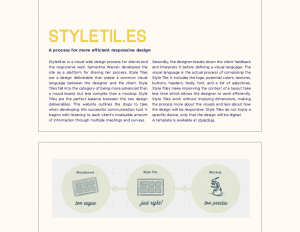For the technology category I researched styletil.es.
This website was created by Samantha Warren who is a Design Lead at Adobe in San Francisco. She created this website to give insight to her design process, which includes the use of Style Tiles. As described in my previous post, style tiles are a way of organizing information to create a common visual language between the designer and the client. Her website breaks down how to use and create style tiles step by step. The first step is to listen to the client through meetings and organizing surveys to distribute. Secondly, the designer takes the information acquired and turns that into a list of adjectives that will be used to help create the style tile (similar to the process of creating a mood board). Next, the designer defines the visual language. This is where Style Tiles become different from mood boards. The word “mood” is often associated with brand and identity design, so the word “style” refers t0 cascading stylesheets (i.e. web design). The visual language includes colors, text hierarchy, the way button will look, etc. The style tiles are pitched to the client in iterations and then are updated to see fit. The benefit of style tiles is that they are created without dimensions. This means that when changes need to be made, they are only made for the visuals before the design is set to be responsive to multiple devices. This saves a lot of time for the designer and reduces the amount of mock-ups that will be made.
Chapter 4 is about saving time with style inheritance. This is the process when CSS properties are applied to one tag and are passed on to nested tag. This means that if a <body> tag is given a property that all the tags inside (such as a <p> tag) will also have these properties unless otherwise noted.
